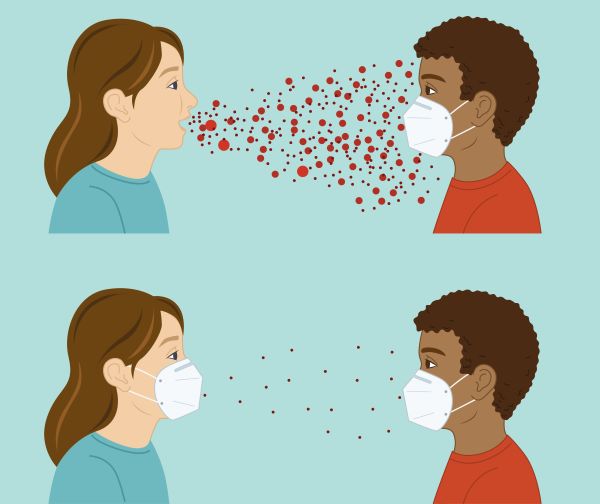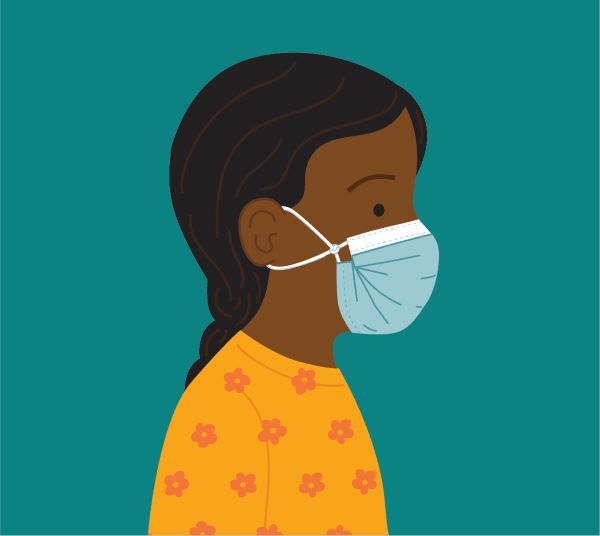
Masks Reduce the Spread of COVID-19
The virus that causes COVID-19 spreads through the air between people when they breathe, talk, laugh, or sing. You do not have to feel sick or be coughing and sneezing to spread the virus. Wearing face masks helps protect the person wearing the mask and those around them. A well-fitted mask helps stop the virus from getting into the air if the person wearing it is infected. Masks also help protect people from breathing in viruses that are in the air around them. Masks are a simple and effective way to help protect yourself and the people around you from getting sick.
Masks Help Protect People at Higher Risk
Wearing masks helps to protect everyone. When adults and children wear masks, they protect others who are at higher risk for severe illness. This includes babies under 6 months who are too young to be vaccinated against COVID-19 and children under 2 who cannot wear masks. This also includes children and staff who have immune problems, are affected by certain chronic illnesses or disabilities, or are not up to date on COVID-19 vaccinations. Early childhood programs may consider requiring masks at any time to protect people who are at higher risk of illness in their programs.
Masks Add Protection When COVID-19 Levels Are High
Masks are an effective COVID-19 risk reduction strategy that can be scaled up and down as part of an evidence-based COVID-19 mitigation policy. Programs may consider requiring masks as a layer of protection against COVID-19, especially when local COVID-19 community levels are high. Explore COVID-19: Risk Reduction Strategies for more information.
Some People Cannot Wear Masks
Masks should not be worn by:
- Children who are under 2 years old.
- Anyone who cannot remove their own mask.
- A child who has a special health care need and whose health care provider advises the family that their child should not wear a mask.
- People who cannot safely wear a mask because of a disability as defined by the Americans with Disabilities Act (ADA).
- People while they are eating or drinking, brushing teeth, resting, or sleeping.
Types of Masks
Start each day with a clean mask and replace any mask that becomes wet or soiled during the day.
There are different types of masks, and some are more effective than others. To work effectively, all masks for children and adults must fit snugly and be worn consistently. The table below shows which masks offer the most protection.
| Most Effective* | Effective | Least Effective |
|---|---|---|
| Disposable procedure masks (sometimes called medical or surgical masks) | Cloth masks |
Buy masks from reliable sources. Project N95 is a helpful site for individuals. *The numbers 94 or 95 mean the mask filters 94% or 95% of airborne particles. | Disposable masks with ASTM (American Society of Testing and Materials) ratings have been tested to make sure they adequately filter the air. | Cloth masks are most effective if they have:
|
Masks for Adults
Adults should choose the most effective mask that is comfortable and that they will wear consistently. They should wear cloth masks only if more effective masks are not available.
Masks for Children
 Children should wear the most effective mask that is comfortable and that they will wear consistently. It is harder to find masks to fit children's faces snugly. Some masks for adults do not fit young children.
Children should wear the most effective mask that is comfortable and that they will wear consistently. It is harder to find masks to fit children's faces snugly. Some masks for adults do not fit young children.
- N95 masks are made for adults, and small sizes may fit some older children.
- Some smaller KN95s or KF94s may fit young children.
- Medical/surgical paper masks are more widely available in smaller sizes for children and are preferred to cloth masks. To make medical masks fit better, shorten the ear loops (by knotting them) where they attach to the mask. To find a high-quality mask, search for "ASTM medical masks for kids."
Wearing Masks Effectively
Masks need to fit well and be worn correctly to provide protection. A well-fitted mask keeps the virus from leaking in or out at its edges. Masks also help block the virus from coming through the mask. Follow manufacturer instructions for fitting, putting on, and removing N95, KN95, and KF94 masks.
Well-fitted masks:
- Cover the mouth, nose, and chin.
- Fasten around the ears or back of the head.
- Stay in place when you talk and move.
- Allow easy breathing.
Handling Masks
Follow these steps to reduce exposure to any virus that may be on the inside or outside of a mask.
- Wash your hands for 20 seconds with soap and water before and after touching your mask (such as when putting it on or taking it off to eat or drink).
- Wash your hands before and after helping a child with their mask (such as when putting it on or taking it off to eat, drink, brush teeth, rest, or sleep).
- Try to touch only the ear loops or ties. Avoid touching the part of the mask that touches the mouth and nose.
- When children are eating, brushing teeth, or napping, store their masks in a paper bag or breathable container labeled with their name.
- Whenever taking off a mask, remember which side was facing the child's mouth, and put in back on the same way.
Reusing and Caring for Masks
Start each day with a clean mask.
Reusing Masks
- N95, KN95, or KF94 masks can be reused. Throw them away when they become wet, soiled, or damaged, if the straps become loose, or the mask no longer fits snugly.
- Medical/surgical paper masks can be used for one day. Throw them away at the end of each day, or sooner if they become wet, soiled, or damaged.
- Cloth masks can be reused if they are not damaged, and if they fit well and are washed daily.
Caring for Cloth Masks
- If a cloth mask becomes wet or dirty, set it aside in a plastic bag until it can be washed.
- If a cloth mask is dry and clean, store it in a paper bag or breathable container between uses in the same day (such as to eat, drink, brush teeth, rest, or sleep).
- Wash cloth masks once a day.
- Wash and dry masks by hand or using a washer and dryer.
- Completely dry masks before reusing them.
Strategies to Help Children Feel Comfortable with Masks
Most children are used to wearing masks and seeing people in masks. It is easier for children to learn new behaviors such as wearing a mask when the adults who care for them model these behaviors. Predictable and consistent routines for mask wearing can help young children feel more comfortable and know what to expect.
Mask wearing is an emerging skill.
- Children should never be disciplined for not wanting to wear a mask.
- Help children learn how to wear a mask consistently to be healthy and safe by showing them how to wear their mask so it fits securely over their mouth, nose, and chin.
- Help children find a mask that is comfortable and that they can keep on all the time.
- Give positive feedback to children for their efforts, and keep it playful!
Social stories may be helpful in making children comfortable wearing masks. Children love to read stories that include their pictures and photos of people they know. You can make your own social story with photos of adults and children in your program.
The American Academy of Pediatrics offers families ideas for helping children get used to wearing a mask. Sesame Street in Communities has created short videos where familiar characters practice wearing masks.
Read more:
Resource Type: Article
National Centers: Health, Behavioral Health, and Safety
Audience: Families
Last Updated: May 22, 2024